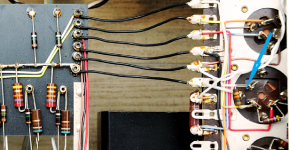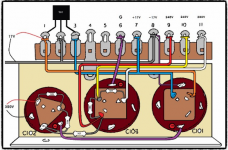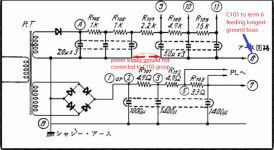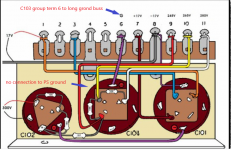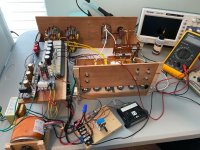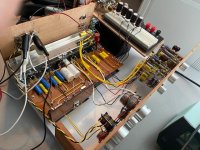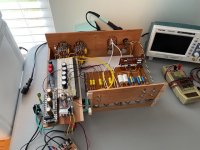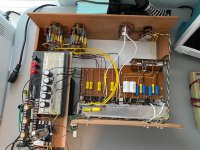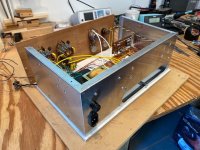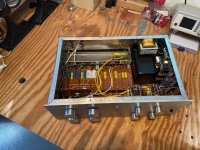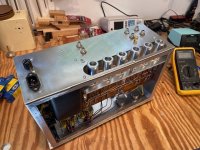Biasing under 1V isn't a problem for ECC83. You create a problem where no problem is.
If you study the great classics, you will notice that those working points have been choosen with all tubes all day long and very successfull.
Surely not in every amp, but in many.
If you study the great classics, you will notice that those working points have been choosen with all tubes all day long and very successfull.
Surely not in every amp, but in many.
Last edited:
I've got most of the circuitry figured. I'm curious as to what was the grounding path from the turret board buss onward. Looks like they tied the buss into C103 case ground but I'm not able to see any decent photos showing the rest of the grounding scheme.
Looking for help from anyone familiar with other grounding path from the three cans onward and if all three cans are isolated from chassis?
Looking for help from anyone familiar with other grounding path from the three cans onward and if all three cans are isolated from chassis?
Attachments
There were metal and hard- paper mounting plates for those twist- prong can caps.
Obviously you have the hard paper types and those are isolating from ground.
You are free to do the grounding path as you may find OK. With the others, you are not free, because they make contact to the chassis.
Obviously you have the hard paper types and those are isolating from ground.
You are free to do the grounding path as you may find OK. With the others, you are not free, because they make contact to the chassis.
The more I delve into the grounding scheme of a 7c, the more it doesn't make sense. I've included a couple of images showing that the longer of the two turret board ground busses connect to term #6 which connects to PS multi cap C103. But, the PS ground path feeding C103 is not connected directly to the PS as is C101 and C102.
So, what I could use help in solving is what is the ground path feeding the longer ground buss since it doesn't directly connect to the power supply ground?
So, what I could use help in solving is what is the ground path feeding the longer ground buss since it doesn't directly connect to the power supply ground?
Attachments
Grounding isn't as trivial as most of the DIY think.
One reason for tricky grounding schemes is that different grounding styles are clearly audible, because its an important part of the current path.
I saw those with some cult- asian following preamps as well, but its some decades ago.
Today, I do grounding as it was done in studio equipment. Strictly to the rules.
The amps doesn't sound more bad, but the topology is more clear and easy to read.
If the Marantz guys have done it that way, just copy it. Don't think about it. They may have heard differences, so they have done the work and its finished, a ready made design.
One reason for tricky grounding schemes is that different grounding styles are clearly audible, because its an important part of the current path.
I saw those with some cult- asian following preamps as well, but its some decades ago.
Today, I do grounding as it was done in studio equipment. Strictly to the rules.
The amps doesn't sound more bad, but the topology is more clear and easy to read.
If the Marantz guys have done it that way, just copy it. Don't think about it. They may have heard differences, so they have done the work and its finished, a ready made design.
what I could use help in solving is what is the ground path feeding the longer ground buss
since it doesn't directly connect to the power supply ground?
The second can is not directly connected to the first can to lower noise and hum. The first can
has the rectifier's charging current pulses going through it, and so the second can is connected
to a more quiet point on the grounding system. Where exactly that is, has to be found visually.
Last edited:
As Rayma said the power ground not connected at C103 is to make sure the rectifier currents going straight back to the transformer. Want you don't want is for the currents to enter signal ground of your amp. Keep current loops local. People talk of star grounds but that's just a simple way of getting it correct.
Last edited:
For all comments, thank you! I agree whole heartedly on the need to separate noise prone areas from sensitive ones especially ones as noise prone as a phono stage. I get that as I've gone through grounding designs that looked great on paper but needed just this or that tweak to keep from being noisy as hell.
My intent is to not "reinvent the wheel" so to speak but want to fully understand what they did with the ground scheme of the 7C. Unfortunately, my limitation is not having a 7c to pop the hood and trace it out and I think I've exhausted all sources of photos on-line that may have a chance of showing the other ground connection of both the short buss at phono V1 and the longer buss for V2 - V6.
If anyone is willing to take a peak at their 7c to help me figure this out I would be very appreciative! I'm open to the barter system as well.
My intent is to not "reinvent the wheel" so to speak but want to fully understand what they did with the ground scheme of the 7C. Unfortunately, my limitation is not having a 7c to pop the hood and trace it out and I think I've exhausted all sources of photos on-line that may have a chance of showing the other ground connection of both the short buss at phono V1 and the longer buss for V2 - V6.
If anyone is willing to take a peak at their 7c to help me figure this out I would be very appreciative! I'm open to the barter system as well.
The grounding system used in the original 7C may very well not apply to a version
that is built differently, with different parts. If you are building an exact replica, it would.
that is built differently, with different parts. If you are building an exact replica, it would.
I agree with your statement. The changes I'm making is pulling the low and hi filters, the output trim pots and changing to individual pots in place of a ganged balance control. Obviously getting rid of the extraneous, non-necessary older non-riaa and tape selector options. All else including tone amp will be as close as possible to an exact replica.
Last edited:
I really wonder why someone in theses days makes such a great effort to rebuild such an old preamp. I don't think that its a bad one, its one of the classics and highly valued by some (mostly asian) audiophiles.
But in other perspectives, its such a faulty design which can be upgraded and improved upon with the same efforts.
I mean, to build a box and put a better circuit, same parts or better parts inside is nearly the same amount of time. From my perspective, I would throw this cathode followers out and put a real good output transformer in. Marantz didn't do that, because too expensive for them. That would help alot. And get rid of the cathode follower of the phono stage, no one needs this with a little skill in circuit design. Or, if you love cathode followers, put an active CCS inside the box and even this makes this amp to play on a different level. A formerly mediocre sounding pre wouldn't get better than the original at all. And this one was remarkable not able to cut the edge of tube amps when I tried it. A simple Shindo pre pushed it out of the race, and it wasn't even an expensive one.
That shows, where the performance of this pre has to be ranked. It could be done so much better today.
But in other perspectives, its such a faulty design which can be upgraded and improved upon with the same efforts.
I mean, to build a box and put a better circuit, same parts or better parts inside is nearly the same amount of time. From my perspective, I would throw this cathode followers out and put a real good output transformer in. Marantz didn't do that, because too expensive for them. That would help alot. And get rid of the cathode follower of the phono stage, no one needs this with a little skill in circuit design. Or, if you love cathode followers, put an active CCS inside the box and even this makes this amp to play on a different level. A formerly mediocre sounding pre wouldn't get better than the original at all. And this one was remarkable not able to cut the edge of tube amps when I tried it. A simple Shindo pre pushed it out of the race, and it wasn't even an expensive one.
That shows, where the performance of this pre has to be ranked. It could be done so much better today.
Last edited:
I often hear this about the old Mac C22 and the 7C. I've always owned loudspeakers with horn loaded mids/highs. The combination of a C22 or a 7C with my solid state amps, my speakers, in my listening room produces magic that no other combination can match. Perfect tight bass, unbelievable 3 dimensional mids and highs with no edge. I've tried "better" modern tube pre's and while I'm sure they are much better in all areas of performance, they don't produce the goods with the rest of my system.
Most people are the same with cars and boats, why we like this or that model has more to do with our particular tastes and how they feel than how fast they go and level of quality.
Most people are the same with cars and boats, why we like this or that model has more to do with our particular tastes and how they feel than how fast they go and level of quality.
I've tried "better" modern tube pre's and while I'm sure they are much better in all areas of performance, they don't produce the goods with the rest of my system.
Build what makes you happy. I like a preamp that has some flavors or colors. I am usually well awared that I am not listening to absolute fidelity to the SOURCE, which is the recording itself and it might be boring. Use objective means to achieve subjective end. Go for it.
I am usually well aware that I am not listening to absolute fidelity to the SOURCE, which is the recording itself
Same here. I will have to admit that by choosing to stick with my present amps and speakers, it necessarily biases my perception of old tech tube versus more faithful modern tube designs.
I'll also have to admit that another driver in my decision to build a slightly reduced version of the 7c is nostalgia since my first exposure to great sounding audio was 40 years ago when I purchased a Mcintosh C22. I unfortunately sold it a few years ago during a financial crisis and feel like I gave up a child and want it back.
After this project, I would like to take stab at a more refined tube preamp and shop for speakers that would be able to show it's merits.
McIntosh C22 is basically the same circuit as Marantz 7C, so someone has done a good copy job here. I don't know whom of those was the inventor of the circuit design, but obviously someone else has copied that design with minor changes.
We are talking consumer tube preamp of the golden tube era from the US here.
Both share the same parts, building style etc.
Its obviously, that there are far better tube audio designs. Technically better means, if you use good parts, you will get better sound.
But thats not what your goals are here, so I bet you will be fine with one or another of those twins.
As they were mass market products for the upcoming tube audio market. there is no problem to buy them again today in good shape and condition.
We are talking consumer tube preamp of the golden tube era from the US here.
Both share the same parts, building style etc.
Its obviously, that there are far better tube audio designs. Technically better means, if you use good parts, you will get better sound.
But thats not what your goals are here, so I bet you will be fine with one or another of those twins.
As they were mass market products for the upcoming tube audio market. there is no problem to buy them again today in good shape and condition.
Last edited:
My Marantz 7 build had to be parked for a while due to various life issues but I have restarted the project and am up to the point of performing listening tests and all systems are go at this point with no issues which was definitely unexpected. My grounding layout, even though not exactly as Marantz had laid it out, worked nicely and is mostly dead quiet except when cranking the volume past 3/4 turn. Left to do is assemble the aluminum enclosure and transfer everything from my test frame to the enclosure and will shoot photos when complete. Thanks to everyone who helped with this project along the way!
Attachments
Thanks Rayma. Actually, these older photos I posted with filter portion of the power supply on a breadboard makes it look like it would take a lot of real estate but the preamp will be the same dimensions as the 7 except for the depth being 10" instead of 8". Width and height will be identical.
Due to various life issues, my Marantz 7C build was on the shelf for quite some time but have finally completed it! The preamp sounds great and is quieter than any tube preamp I've owned in the past. Phono sound quality is excellent to my ears. I recently put on an old vinyl of Miles Davis Kind of Blue and is magical.
I'll post a few photos of various stages of completion including my cabinet build. These four show aluminum chassis in progress and transitioning from my wood panels used in the testing stage to the final aluminum chassis.
I'll post a few photos of various stages of completion including my cabinet build. These four show aluminum chassis in progress and transitioning from my wood panels used in the testing stage to the final aluminum chassis.
Attachments
- Home
- Amplifiers
- Tubes / Valves
- Marantz 7C Build
